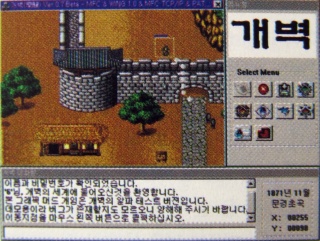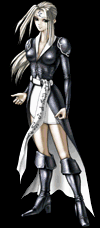A History of Korean Gaming
재미시스템개발 Jamie System Development

|
Founded: |
January 6, 1996 |
|
Status: |
assimilated by JCE (September 2000) |
|
Key People: |
李德漢 이덕한 Lee Dukhan: |
|
Website: |
www.jamie.co.kr (offline) |
Starting as a subsidiary of Asia-Pacific Infoserv, Inc.,1 Jamie remained a mostly inconspicuous little company during its time, despite some interesting titles. While it had always been its declared goal to conquer foreign markets, the company's height certainly was around 1998/1999, when its 3D games were successfully showcased at various expositions around the world, starting with E3 1998 in Atlanta2. In 2000, Jamie System was bought by the emerging online games giant JC Entertainment3.
Before long, however, creative differences became evident, and president Lee Taejung and his team left Jamie System4 for the studio to slowly vanish within the bigger company. Afterwards, many former Jamie System employees went on to work for the newly founded developer Joyspell (CEO Sin Ingyeong)5. Joyspell created the 3D community game TTL Fingo (2003) and the MMORPG Mic Mac Online (2006).
Games
아트리아대륙전기 (Atria Daeryuk Jeon'gi) / The Story Of Atria Land - IBM PC, Windows (January 16, 1997)
Quite unusually for an RPG, Atria's battles are fought brawler style in real time. The player can switch around between party members, everyone else is controlled by the AI. Dungeons are focused on puzzles, and the idea was to give each member of the party a special purpose in solving them. It seems Jamie forgot about that concept after implementing the first two characters, though. A planned day-night cycle wasn't implemented, either.
The story around the search and battle for 12 mythical artefacts is much more conventional, and haphazardly written. The villains' plot to trick two nations into war is quite interesting, on the other hand stands the usual crappy romance that comes out of nowhere and a main protagonist whose only motivation to take part in the quest is because he's got nothing else to do. It's also quite mysogynistic, putting all the female characters in the most miserable roles.
The graphics are a nice lookout of what hi-res spritework was headed to before everything was taken over by shitty rendering, although the characters retain the expressive range of 16-bit Final Fantasy heroes. There's a lot of goofy slapstick that is in no way related to the narrative. The ending is also quite the downer, it literally closes with the typical game over screen that is displayed after losing in a battle. There's not even a credits scroll (though Jamie announced that programmers of Astonishia Story, Cheonha Mujeok and The Romance of Forgotten Kingdom worked on the game1). There have been allusions to a hidden "good" ending after unleashing the powers of all 12 artefacts, some of which have their own sidequests and dungeons, while others are just hidden invisibly at arbitrary and inconspicious locations. However, either it's not in there or the trigger is broken.
Finally, the game has the usual balancing issues at their worst. The whole quest takes no more than roughly ten hours, but the final couple of bosses have so ridiculously high HP that they alone account for two hours, the alternative being grinding for another ten. Optimized for Windows 95/98, it's also very hard to get running properly in modern operating systems.
After it was showcased together with many other Korean games at ECTS 1997, Jamie was in negotiations with several Western publishers to localize the game, and reportedly there was even a contract closed with a company from Hungary6, but currently it is not known whether that led to a release there.
개벽 (Gaebyeok) - Windows (October 1, 1997)
Not much is known about Jamie's MUG, only that it was set on the Korean peninsular during times of peasant rebellions in the late 19th century, and that the initial server supported 1.000 players at a time7.
Gaebyeok (Windows)
Quick Info:
|
Developer: |
Jaemi System |
|
Genre: |
RPG |
|
Theme: |
Korean History |
황금 임파서블 (Hwanggeum Impossible) / Golden Impossible: Quest for Golden Ruins - Windows (December 1997)
The FMV conspiracy thriller had a very unusual look with prerendered puppet-like characters in front of photographed backgrounds, but unfortunately it used some ancient licensed player technology and is therefore positively impossible to run nowadays.
Eryner (이리너) - Windows (December 30, 1997)
Based on the winner of a 1996 scenario competition titled "Pandora-wa Pangea Iyagi" (판도라와 팡게아 이야기)8, Eryner features rather conventional combat but an unique setting, contrary to Jamie's first RPG. The hero in this game possesses a magical mirror with which he witnesses a duel between his best friend and an unsympathetic aristocrat. After accidentally killing his opponent, he is taken prisoner by the royal guard. The friend now tries to get him freed, but first he has to do a number of quests for the king before his plea will be heard.
The characters are controlled just like in an RTS or many Western RPGs of that era, for example Baldur's Gate. It's always reccomended to turn on the AI, as manual combat controls are terribly unresponsive. Unfortunately, the gameplay is really slow, and there's not much for the player to do while waiting till the heroes reach the end of a map or kill the inventively designed monsters. Characters can run, but only until their stamina runs out, which happens all too quickly.
The dialogues in Eryner are fully voiced, and interestingly there are even English subtitles, although they're apparently not translated by a native speaker and completely ignore linebreak rules, and it doesn't seem like the game has ever been published in an English speaking country. Never mind though, because the shoddy QA makes it very much unplayable. The fact that the installation simply doesn't work on modern systems can be worked around, not so much the many severe bugs like missing background graphics, crashes, broken save games and—worst of all—crucial events that just won't be triggered.
아트리아2~부활~ (Atria II: Buhwal) / Atria II: The Ressurection - Windows (December 1998)
Cover
The sequel to Jamie's first game also ditches pixel art for render graphics, and puts much more emphasis on the brawler combat, complete with 2-player coop. The overworld is a single screen now, and squares have to be unlocked by using "map chips" on them. Dungeons are one screen mazes, too, but you only ever see the character's immediate surroundings, the rest of the building is veiled in darkness. Every step here consumes torches, and the player is forced to leave the dungeon when they run out.
The combat unfortunately is not that much enhanced over the predecessor, and even feels a little more stiff. Special move input is not very intuitive, and one has to hold the attack button for a second to access spell selection and AI settings in real time.
The game is also not as story driven, instead the party just runs around menu based villages, takes jobs from local hero guilds and runs around the map for more fighting.
Xtom 3D (엑스톰 3D) - Windows (July 1999), Arcade (August 15, 1999)
Cover
Xtom 3D was Jamie's first game after the joining of former Mirinae designer Kim Kyongsoo and programmer Park Jaehong, who were pushing for a new direction towards action games. Released both in the Arcades and on PC, Xtom 3D is a pure old-school 2D shmup, although it looks like a tunnel shooter. The perceived depth is all fake, though, and the player's ship is moved on a 2D plane, which is merely tilted into the 3rd dimension.
This perspective makes the game confusing at times, but it also makes it one of the most exciting entries into the genre, and althoug the graphics aren't technically impressive, they game looks great in motion. The three available ships couldn't play any more different: The Xtom is a pretty standard shooter vehicle with upgradeable gun, while the VX-Mkll relies on a fleet of "option" sidekick ships, and the Warlock uses a selection of non-standard weapons, which need some getting used to. Weapons are upgraded by gaining experience points RPG-style, but every time the player is hit, the ship is set back one level.
Axis (액시스) - Windows (January 19, 2001)
Axis combines the online arena FPS gameplay of Unreal Tournament and Quake 3 Arena with fully customizable flying mechas a la Gundam. The game was released in the west through Realnetwork's online service, where it gathered a cult following for a couple of years.
Although Jamie planned a full single player campaign for Axis and had an elaborate story (also in English) prepared, that never happened and the game remained online only.
Axis was also somewhat popular in Korea, yet not quite successful, as the number of online players was much greater than the number of games sold.9
American Cover
Unreleased Titles:
신 제네레이션 / Neo Generation (1997-1998)
남자 만들기 (Namja Mandeulgi) (1997-1998)
References
1. a b Gamepia 12/1996, page 221
2. http://www.stockall.co.kr/company/view/view1.php?num=3382&mode=sort&keyword=%A4%B8
3. iNews 9/5/2000
4. PC Power Zine 9/2001, page 160
5. Game Meca 08/10/2005
6. PC Champ 11/1997, page 118
7. Seoul Shinmun 9/5/1997, page 30
8. ET News 02/28/1997
9. Interview with Kim Kyongsoo










































































